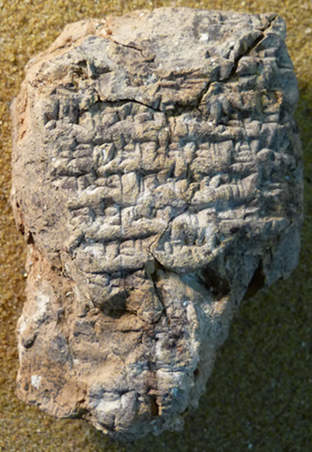The deputy system: backbone of Assyrian governance
A coherent system that assigned every state official of a certain rank a deputy underpinned the Assyrian empire's administration. These deputies could replace their superiors whenever the need arose and made Assyrian governance flexible and resilient.
The deputy system and its origins
Of course, the entire Assyrian administrative hierarchy was based on the idea of substitution as the king himself was acting as the "vice-regent" (iššakku, a loan word from the Sumerian ensi) of Aššur, the god's earthly representative, following an ancient Mesopotamian tradition that can be traced back to the city states of the third millennium BC.
The word šaniu, the Assyrian term used for deputies, means literally "the second one". In combination with a specific office, the term is often translated as "vice" or "deputy", e.g. "vice governor" or "deputy palace scribe". The earliest attestation for a deputy can be found in a ritual text of the Middle Assyrian period, from the 13th century BC, which mentions the deputy vizier acting together with the grand vizier (sukkallu rabiu) in the ceremonies held on the occasion of the coronation of the Assyrian king. Although the idea of having a deputy is not an innovation of the Neo-Assyrian period, the deputy system was certainly developed at that time.
A deputyship was meant to be a permanent office. A deputy did not replace a superior official on an ad hoc basis but held his function in the long term. A good example is the deputy team commander Nabû-eriba who is attested with this title in more than twenty legal documents in the period between 670 and 660 BC.

The king's deputy: the commander-in-chief
"Day and night during my reign, you shall be my magnate and my deputy. You shall stand in my place; guarding you is for guarding me. Don't be negligent but keep watch for me." (ND 2361 = SAA 19 2)
This passage is found in a letter from the king, either Tiglath-pileser III or Sargon II, to his commander-in-chief, in Assyrian turtānu. This title is of Hurrian origin and literally means "second-in-rank (in the state)". It is among several administrative ranks that the Middle Assyrian kingdom adapted from its predecessor and former overlord, the Hurrian state of Mittani. In the Neo-Assyrian period, this official's most prominent function was to command the army, and he is frequently attested leading the troops instead of the king who is otherwise the supreme commander of the Assyrian forces. The best example is Dayan-Aššur, the commander-in-chief of Shalmaneser III (858-824 BC) who routinely led the army in his king's stead in Shalmaneser's old age. This eventually resulted in an open conflict with the crown prince, Aššur-da''in-aplu, that divided Assyria and led to several years of succession war.
Under normal circumstances, however, when the king was in good health and in command of his mental faculties, the power assigned to the commander-in-chief, and other high officials, served as collateral against a crown prince's ambitions.
The deputies of the magnates
Although there are gaps in the available documentation, it seems clear enough that all seven officials who held the highest functions in the Assyrian empire - commander-in-chief, treasurer, chief cupbearer, chief eunuch, palace herald, vizier and chief judge - had deputies. They wielded considerable power, as the letters of Šulmu-beli, deputy of the palace herald under Sargon II, attest (SAA 5 133-144, ND 2402 = SAA 19 185).

All provincial governors had deputies, and due to their considerable number this group of deputies is by far the best attested in our sources. The top of the administrative hierarchy of any Assyrian province consisted of the governor, his deputy and a scribe. All other provincial administrators and the military were under their orders. When the governor's duty to the Assyrian king required his absence from his province, e.g. in order to participate in a military campaign or to visit the royal court, his deputy routinely took care of the province in his stead.
As one would expect, the deputies were not their superiors' equals in status or wealth, but came second to their superior. According to the 7th century scholar Urdu-Gula, the office holders travelled on palanquins and their deputies on carts (SAA 10 294). But this does not mean that deputies were not influential. They were appointed directly by the king or alternatively, but only if the king explicitly so chose, by their superior (ND 2426 = SAA 19 97). The more usual direct appointment suggests that the institution of deputy was seen not merely as a means of enabling the superior to work more efficiently but equally as a royal instrument of control. As the deputy owed his appointment to the king it was with the crown that his loyalties were expected to lie.
Always prepared!
But deputies were not limited to the top echelons of the Assyrian administration. It was not only the magnates who had deputies but also senior military officials (and, of course, the job description of the magnates included military responsibilities) and court officials, such as the palace scribe, the chief scribe and the chief physician.
The deputy system provided the Assyrian administration with resilience and flexibility. In military and civil contexts, it provided a clear chain of command. In a state as large as the Assyrian empire where geographical distances created obstacles for quick responses to misfortunes, which in the case of military action habitually must have included death or grave injury, the deputy system ensured that there was always a substitute available who could take over the office with a minimum of disruption.
Further reading:
Mattila, 'The king's magnates: a study of the highest officials of the Neo-Assyrian empire', 2000.
Postgate, 'The invisible hierarchy', 2007.
Content last modified: 5 Nov 2012.
Mikko Luukko
Mikko Luukko, 'The deputy system: backbone of Assyrian governance', Assyrian empire builders, University College London, 2012 [http://www.ucl.ac.uk/sargon/essentials/governors/thedeputysystem/]